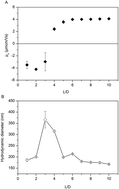The effect of a fluorinated cholesterol derivative on the stability and physical properties of cationic DNA vectors
Abstract
Liposomes of the cationic lipid DOTAP (1,2-dioleoyl-3-trimethylammonium-propane) and the fluorinated cholesterol derivative heptafluorocholesterol (F7-CHOL) were tested at the molar ratio of 1 : 1 for DNA compaction and transfection. Their properties were correlated with the characteristics of the well-known system, DOTAP and cholesterol (CHOL). The mass lipid–DNA (L/D) ratios at the isoelectric point were within the ranges 3–4 for DOTAP:CHOL and 4–5 for DOTAP:F7-CHOL, as determined by electrophoretic mobility measurements. These results and the ethidium bromide fluorescence intercalation assays confirmed that more DOTAP:F7-CHOL liposomes are needed to compact the same amount of DNA as DOTAP:CHOL. The phase diagrams of aggregation and re-entrant condensation phenomena obtained by phenomenological theory support this conclusion and also establish that the liposome–DNA binding is stronger in the case of the DOTAP:F7-CHOL–DNA system. The stability rates of both liposomes in the presence of DNA and their transfection efficiencies were similar, which support the application of heptafluorocholesterol as a helper lipid in cationic liposomes for DNA delivery.


 Please wait while we load your content...
Please wait while we load your content...